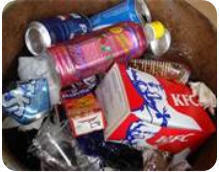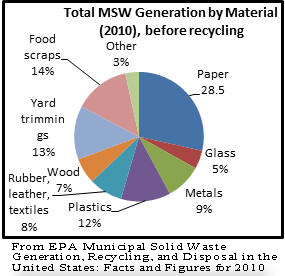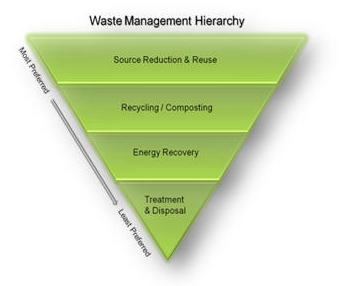Solid Waste
What is Solid Waste?
 Solid waste is made up of all the things we use and then throw away, such as paper, packaging, metal, and food waste. A little over half the solid waste generated in America is collected and disposed of in landfills. Overall, about 34% is recycled or composted instead of going to a landfill and about 13% is incinerated, a portion of which is combusted to generate electricity.
Solid waste is made up of all the things we use and then throw away, such as paper, packaging, metal, and food waste. A little over half the solid waste generated in America is collected and disposed of in landfills. Overall, about 34% is recycled or composted instead of going to a landfill and about 13% is incinerated, a portion of which is combusted to generate electricity.

Why is solid waste a problem?
Composition
In ancient times, solid waste was composed mainly of food wastes, ash from fires, bones, and wood, and was usually discarded on the ground, where it would act as compost to improve the soil. Over time and especially since industrialization, what Americans throw away has changed considerably. Today, solid waste is composed of many synthetic and potentially toxic materials.. Paper, plastics, and organic wastes, make up the largest parts of the waste stream, and most of it comes from packaging. That is why proper disposal is so important. It is important not to burn garbage or dump waste other than at a designated waste disposal facility, which has mechanisms in place to prevent harm to the environment.
Volume
Over thousands of years, populations and cities throughout the world grew and waste built up in urban areas, creating odor, rodent, and disease problems. It became necessary to develop systems to manage solid waste due to the increasing amount of waste produced. Today, the average American generates 4.43 pounds of trash each day! Although landfills have measures in place, such as liners and leachate collection systems, to prevent solid waste from contaminating groundwater or surface water, they take up a lot of land area and the waste takes a long time to break down because of anaerobic conditions (the lack of oxygen). Because of this, landfills are running out of room. Even though landfills are a better choice for solid waste disposal than burning or dumping, reducing and preventing the amount of waste needing disposal is even better.
Pollution
While solid waste incinerators have pollution control technologies in place, they still emit some emissions, some of which contribute to climate change. These emissions are called greenhouse gases (GHG). Landfills also emit emissions, mostly methane, which is a greenhouse gas. Greenhouse gas and other emissions are also generated by trucks and equipment hauling solid waste.
Solutions to the problem
Effective and efficient waste management is the solution to the environmental problems posed by solid waste generation. There are many strategies used in solid waste management, which the U.S. Environmental Protection Agency (EPA) has ranked by environmental soundness in the ‘Waste Management Hierarchy’ from most preferred to least preferred.
Source Reduction & Reuse (or waste prevention): means reducing waste at the source so that there is less that needs to be disposed of. Ways to reduce or prevent waste include buying and using less, buying in bulk and things is less packaging, reusing or donating items, buying and using less toxic products, and redesigning products. This strategy is the best way to manage (and eliminate) waste.
Recycling/Composting: means sorting and processing used, reused, or unused items into raw materials and remanufacturing into new products. ‘Closing the loop’ means buying items made of recycled content. Composting is nature’s way of recycling and means making food scraps, yard waste, and other organic materials into fertilizer for the garden and soil. This strategy is better for the environment than energy recovery, incineration, or landfilling.
Energy Recovery (waste-to-energy): means converting non-recyclable waste into energy (electricity), heat, or fuel by combustion, anaerobic digestion, landfill gas recovery, etc. While this strategy is preferred less than the first two strategies, this is a better alternative to landfilling and incineration.
Treatment & Disposal: refers to the common methods of waste disposal - landfills and incineration (combustion). Landfills are the most common form of waste disposal. Incineration is done to save landfill space. Both methods must meet stringent requirements and have measures in place to reduce pollution and impact on the environment, such as landfill liners and pollution control technologies. While this is the least preferred strategy, it is better than disposing of waste by dumping or burning it.
| Remember: NO DUMPING, NO BURNING, NO BURYING! Respect Our Resources! |

